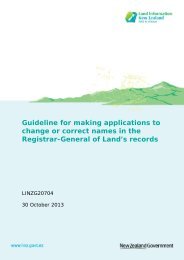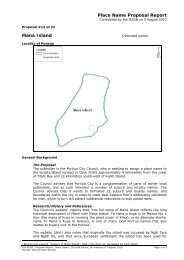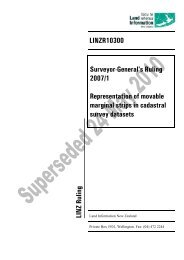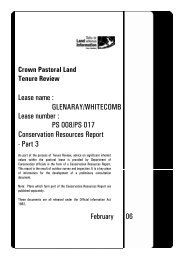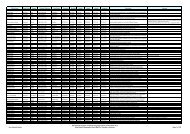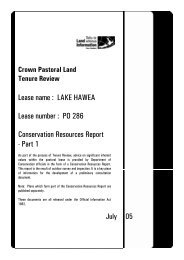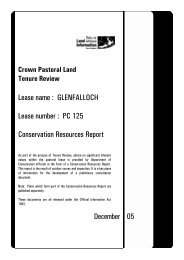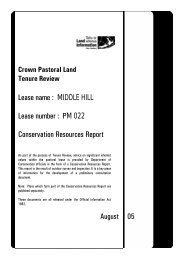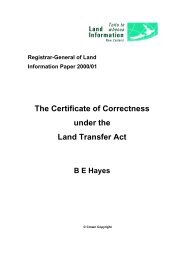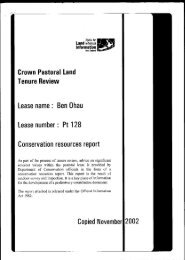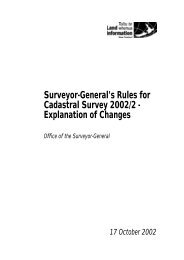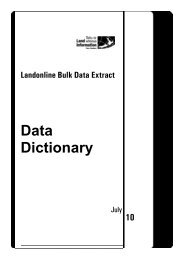Part 1 - Land Information New Zealand
Part 1 - Land Information New Zealand
Part 1 - Land Information New Zealand
Create successful ePaper yourself
Turn your PDF publications into a flip-book with our unique Google optimized e-Paper software.
RELEASED UNDER THE OFFICIAL INFORMATION ACT<br />
<strong>Land</strong>form: Rock block slide<br />
District:<br />
Clutha<br />
Importance: B (National Importance)<br />
Locality:<br />
Alongside Kawarau River extending 4 km between Roaring Meg and<br />
Scrubby Stream<br />
Significance: An extremely good example of a large-scale movement<br />
Vulnerability: 3 (unlikely)<br />
Hazards:<br />
No known realistic hazards<br />
Morphogenic: Map reference F41012713.<br />
The main soil types are Carrick Hill soils (upland yellow brown earths) on the plateau, Dunstan<br />
steepland yellow brown earth on the higher altitude faces and Arrow steepland yellow grey earths<br />
on the lower faces. These soils are not particularly prone to erosion under normal circumstances.<br />
If denuded, wind erosion can be severe at all altitudes while water erosion is a problem at higher<br />
altitude if the soil is disturbed by tracks, fencelines and races etc.<br />
Two sites assessed as being of special soil significance are located with the PL (Arand et al.<br />
1991). One site corresponds with RAP Pisa A8 (Lower Meg) and is described as “a good example<br />
of a moderate range woodland vegetation on yellow-grey earths”.<br />
The other site corresponding with RAP A6 (Skeleton Stream) is described as containing “a<br />
moderate range of soil-vegetation associations, including remnants of previously widespread soils<br />
under narrow-leaved snow tussockland and diverse shrubland associations.”<br />
2.2 Significance of <strong>Land</strong>form Geology and Soils<br />
The Geopreservation Inventory site (LAN 183) is of national importance but is deemed not to be<br />
under any significant threat. The PNAP survey did not assess the landforms of the two RAP’s as<br />
being significant.<br />
Arand et al. (1991) rank the Lower Meg significant soil site as being of national significance and<br />
vulnerable to damage whilst the Skeleton Stream site has been assessed as being of Regional<br />
Importance and also vulnerable to damage/degradation.<br />
2.3 <strong>Land</strong> Environments of <strong>New</strong> <strong>Zealand</strong> (LENZ)<br />
There are two databases that have been used to assess biodiversity protection (Walker et al 2003).<br />
1. Environmental distinctiveness has been assessed through the <strong>Land</strong> Environments of <strong>New</strong><br />
<strong>Zealand</strong> (LENZ). This is a classification of <strong>New</strong> <strong>Zealand</strong> landscapes using a<br />
comprehensive set of climate, landform and soil variables chosen for their roles in<br />
driving geographic variation in biological patterns (Leathwick et al 2002 & 2003). It is<br />
presented at four levels of detail containing 20, 100, 200 or 500 environments nationally.<br />
The most detailed is called LENZ Level IV.<br />
2. The area of unprotected indigenous cover in threatened land environments has been<br />
identified in the national land cover database (LCDB).<br />
From the above databases, spatial data depicting indigenous cover and legal protection were<br />
overlaid on LENZ Level IV environments to identify biodiversity that is most vulnerable (most<br />
likely to be lost). This provides a measure for:<br />
6



